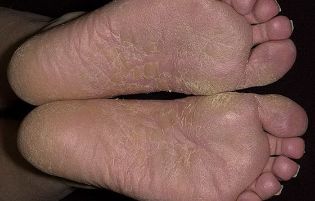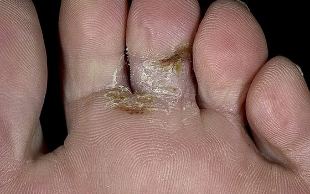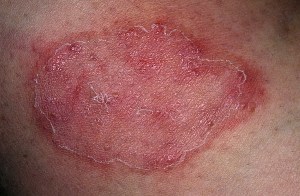Foot fungus (athlete's foot, ringworm) is an infection in which lesions on the skin of the feet, fingers, interdigital areas. Often the pathology is combined with a lesion of the nail – onychomycosis. Cause a fungal infection of microscopic fungi, dermatophytes, molds and yeast strains.

If it is not treated, the fungus spreads from the feet to the entire limb. This in turn increases the risk of the development of erysipelas, the formation of warts, and the frequency of allergic reactions of the skin and mucous membranes. The body will cease to take antibiotics, which complicates treatment of other diseases.
Causes of foot fungus
A contagious foot fungus usually the cause of fungi-Ascomycota. Some of the types of cause rubrofitii, and rubromikoz, occupying more than 70% of the diagnosis of the fungus. About 10% of the total population of the world is suffering from athlete's foot.
Molds and yeast-like fungi that have an influence on the limb the less, they account for 1.5% of the cases.
For that reason, is an infection of foot fungus:
- Somatic pathology.
- Endocrine disturbances.
- Hypothermia of the feet.
- Diabetes with the development of the diabetic foot.
- Dermatological disorders – psoriasis, neurodermatitis, eczema.
- Hallux valgus and other foot pathology.
- Visit the public places where you need to go barefoot (saunas, steam rooms, swimming pools, fitness centres).
- Excessive sweating of the skin of the feet (hyperhidrosis congenital or due to other medical conditions).
- Reduced immunity in children and the elderly. In the 2nd group of the patients with a fungus is often encountered by males, if the nails of your feet have already been affected by the onychomycosis.
- The misuse of antibiotic therapy, corticosteroids, cytostatics, immunosuppressive agents. A factor that has a negative influence on the immune system and increases the incidence of fungal infections.
- The professional community in the development of the mycosis means infection of the staff, baths, swimming pools, metallurgical and coal industry, athletes, soldiers.
- An injury to the skin, which leads to the appearance of a's taking care, fractures, corns.
Favorite places to stop for a fungus followed by the formation of warts become sites of corns and hyperkeratosis. The localisation is caused by the deterioration of the local immune system, losing control over the development of human papillomavirus infection.
The clinical forms of foot fungus
The external symptoms of foot fungus vary depending on the type of the virus that initiated the process, as well as the degree of involvement of the skin, nails and leg hair. The athlete and the rubromikoz, have a similar power, so the doctors have put you in the "athlete's foot".

Types of foot fungus dermatologists, are as follows:
- Scaly.
- The presence of lesions on the skin, similar to a diaper rash).
- Does the performance of the sweat gland.
- Onychomycosis is flowing through the normotroficheskie, atrophic or hypertrophic type.
Describe what it looks like a foot fungus in the squamous cell form. In the initial stages of redness and peeling. Edit the fields and have a variety of areas. Itching does not occur in any of the patients.
The majority of the patients do not notice any signs of athlete's foot. In the clinic, they do not apply, and it gives the pathology of the opportunity to be a change in the scaly form of the disgidroticheskaya.
When disgidroticheskaya the fungus inside the symptoms will be more and more vesicles with a diameter of from 2 to 8 mm. They coalesce into large pockets, are opened to form an erosion.
The arch of the foot fungus to be spread on the outer and inner sides. In addition to the extensive erosion in the place of the bursting of blisters formed diaper rash. The patients were complaining of pain and itchiness and a notice the peeling.
If left untreated, a yeast infection, is complicated by a bacterial. The signs of secondary infection are the clouding of the contents of the bubbles with the transformation into a purulent mass, increase in body temperature, swelling and significant redness.
Intertriginosny foot mycosis is the most common. It is developed either alone or in the back of the squamous cell form. Affects the skin between the fingers 4 and 5, the feet often grow into the space between the 3rd and the 4th toes.
The main symptoms of intertriginous foot fungus:
- Itching and burning sensation.
- The cracks in the skin, in a white frame (the border is formed by the peeling of the epidermis).
- Don't take into account that, in between the fingers of the affected limb.
- Substitute fissures erosions with severe pain in the region.
- Loosening of the skin, with a subsequent reduction in the local immunity. In the loose structure of the streptococci penetrate and cause inflammation of the skin with pus. The tissues swell, redden, enlarge the the the pain. The general condition of the patient deteriorates.
Symptoms of Candida of the foot injury is the interdigital erosion, resulting from over activity of a fungus of the genus Candida. Altered foci are clearly visible in between the 3rd and 4th or 4th and 5th fingers of the lower limbs.
Pain in the skin becomes swollen. Of the healthy tissues, it separates the "rescue" of the epidermis, which is gone. But neighborhood is made up acne and a bladder that.
If the fungus attacks the nails of the fingers, and the patient was diagnosed as "onychomycosis". In the initial stage of the pathology at the free edge of the nail of the big toe is yellow stripes and spots. Hypertrophic onychomycosis is characterized by thickening and brittleness of the plate, which can be seen sloughing of the skin.

In the atrophic falls onychomycosis of the nail structure. Within the framework of a modified plaque-hardened exposed skin. If the onychomycosis develops due to lesions of the foot mold, the nail plate becomes brown, black, green, or yellow. In this process, it is accompanied by paronychia – purulent inflammation of the nail bed.
The diagnosis and treatment of foot mycosis
The foot-fungus-treatment was carried out as efficiently as possible, a physician should visit at the first sign of the disease. Because the signs and symptoms of a yeast infection are not specific and overlap with the clinical picture of other dermatological diseases, a specialist needs to be distinguished from psoriasis, dermatitis, eczema, and systemic lupus erythematosus.
To identify the causative organism and to determine its belonging to any class of fungi, the patient is to be carried out:
- Scraping of the nail.
- Microscopy.
- Microbiological study.
- GREENHOUSE screening materials.
The decision on how to treat foot fungus, or the spaces between the fingers and nails, a dermatologist is considering the possibility of a systemic and combination therapy.
But, without fail, the patient gets an appointment in relation to the external treatment. The basis of the antimycotic therapy is the use of antifungal agents for the different effects of medicines on improvement of local blood circulation, and eliminate comorbidities.
In order to prevent reinfection, the patient is advised, disinfection of personal belongings and household accessories of common use.
System, the foot-fungus-treatment
The products of the system action tablets and capsules for the athlete presented with moderate and severe process. Because of the many adverse effects of their admission are carried out under strict medical supervision.
The removal of the fungus from the foot of the antifungal drugs was carried out in two groups:
- The azole.
- Allylamines.
Also, in the treatment of athlete's foot are found in the use of antifungal agents with fungicidal effect. They are working to increase the suppression and complete destruction of the parasites.
Antifungals local action
In considering how to treat foot fungus, we have to say about the effectiveness of the use of drugs local action. The simplicity of the treatment of the skin, and provide a variety of dosage forms of an antifungal medication. It is ointments, lotions, sprays, creams, drops, and powder, against a foot fungus.
In a complete loss of the nail may decide that his / her removal. The goal is to deduce a colony of the fungus that spoiled the plate, and to increase the efficiency of the use of antifungal ointments. Deletion is carried out either with a sterile surgical or by the use of plasters and ointments, anti-fungus capable of destroying the affected nail.
Antifungal traditional medicine
According to dermatologists, a folk remedy for foot fungus without a pharmacy drugs want to be used in the early stages of development of the mycosis, when there are no apparent symptoms. In other cases, conventional medicine can only Supplement the primary a doctor's prescription. An integrated approach guarantees the patient a quick period of service in the inflammatory focus, and the support of the local immune system.
Recipe home treatment for athlete's foot, with the help of folk remedies:

- Wash with herbal decoction. Oak bark, dried fruits, blackberries, grass, verbena and calendula flowers mixed in equal amounts.3 tbsp phyto collection of a boil on a slow fire, and 200 ml of water. After 20 minutes, the contents were filtered and in the form of heat is used to wash out the problem areas and the application of the coatings.
- Ointment from the ash tree. Sifted wood ashes is combined with the pork lard to make a thick oily mass. The feet, the product is applied morning and evening after cleansing routine.
- Ointment of copper sulphate, and sulfur in yellow. The drug is prepared in a fat-pig, the mixture of the ingredients in a uniform manner. Mass, bring to the boil, then take it to a dark room and wait until it cools down. The foot the handling of sulphur-vitriol fat, exercise a few times a day.
- Baths of milk and tea. Of an armful of fresh herbs pour 2 – 3 liters of boiling water, and should be completed in the capacity of an old blanket. After 3 to 4 hours the infusion on a plant is used and is being used for a foot bath. Session time is 45 minutes. The bathroom is the place once every 2 to 3 days, and the fungal infection will not come down.
- The coffee bath. If you are looking for a simple recipe on "how to treat foot fungus at home" has come to the rescue of the instant coffee. Drinking is firmly steeped in the right amount of water poured into the basin, and increase your legs. The number of treatments – 1 to 2 a day. The task – to destroy pathogenic flora and to eliminate the unpleasant scent that glows with the legs.
- Baths with wine vinegar. Before going to bed, wash your feet with warm water and put it in a basin with a strong solution of wine vinegar. After 3 – 5 minutes at the most, and his feet wear socks soaked in this solution. The procedure provides an antiseptic effect.
In addition, it is necessary to disinfect floors in the bedrooms and a bath, a shower and a toilet. In the future, it is desirable to avoid staying in wet conditions in the common areas.
To prevent
The best preventative measure in the fighting against the fungus that can help prevent disease — enhance the protective properties of the organism. This method is inexpensive, however, the most cost-effective and efficient. Medical and traditional treatments, must be determined by a physician, any medication can cause a dangerous complication, which is then to be fighting a lot more and much more.
In order to avoid reinfection it is necessary to observe the rules of personal hygiene, be sure to disinfect bedding and towels which have been in use. In order for the treatment is timely and effective, it is necessary for you to consult with a medical professional.





























